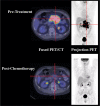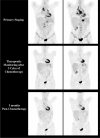Overview of early response assessment in lymphoma with FDG-PET
- PMID: 17766210
- PMCID: PMC1974859
- DOI: 10.1102/1470-7330.2007.0004
Overview of early response assessment in lymphoma with FDG-PET
Abstract
Early assessment of response to chemotherapy with fluorine-18 fluorodeoxyglucose positron emission tomography (FDG-PET) is becoming a routine part of management in patients with Hodgkin lymphoma (HL) and histologically aggressive non-Hodgkin lymphoma (NHL). Changes in FDG uptake can occur soon after the initiation of therapy and they precede changes in tumour volume. Recent studies in uniform populations of aggressive lymphomas (predominantly diffuse large B cell lymphomas) and HL have clarified the value of early response assessment with PET. These trials show that PET imaging after 2-3 chemotherapy cycles is far superior to CT-based imaging in predicting progression-free survival and can be at least as reliable as definitive response assessment at the end of therapy. This information is of great potential value to patients, but oncologists should be cautious in the use of early PET response in determining choice of therapy until some critical questions are answered. These include: When is the best time to use PET for response assessment? What is the best methodology, visual or quantitative? (For HL at least, visual reading appears superior to an SUV-based assessment). Can early responders be cured with less intensive therapy? Will survival be better for patients treated more intensively because they have a poor interim metabolic response? In the future, early PET will be crucial in developing response-adapted therapy but without further carefully designed clinical trials, oncologists will remain uncertain how best to use this new information.
Figures



References
-
- Jaffe ES, Harris NL, Vardiman JW, editors. World Health Organization classification of tumours. Lyon, France: IARC Press; 2001. Pathology and genetics of tumours of haematopoietic and lymphoid tissues.
-
- Raemaekers J, Kluin-Nelemans H, Teodorovic I, et al. The achievements of the EORTC Lymphoma Group. European Organisation for Research and Treatment of Cancer. Eur J Cancer. 2002;38(Suppl 4):S107–13. - PubMed
-
- Zinzani PL. Lymphoma: diagnosis, staging, natural history, and treatment strategies. Semin Oncol. 2005;32:S4–10. - PubMed
-
- Maloney DG. Immunotherapy for non-Hodgkin's lymphoma: monoclonal antibodies and vaccines. J Clin Oncol. 2005;23:6421–8. - PubMed
-
- Josting A, Sieniawski M, Glossmann JP, et al. High-dose sequential chemotherapy followed by autologous stem cell transplantation in relapsed and refractory aggressive non-Hodgkin's lymphoma: results of a multicenter phase II study. Ann Oncol. 2005;16:1359–65. - PubMed
Publication types
MeSH terms
Substances
LinkOut - more resources
Full Text Sources
Other Literature Sources
Medical
